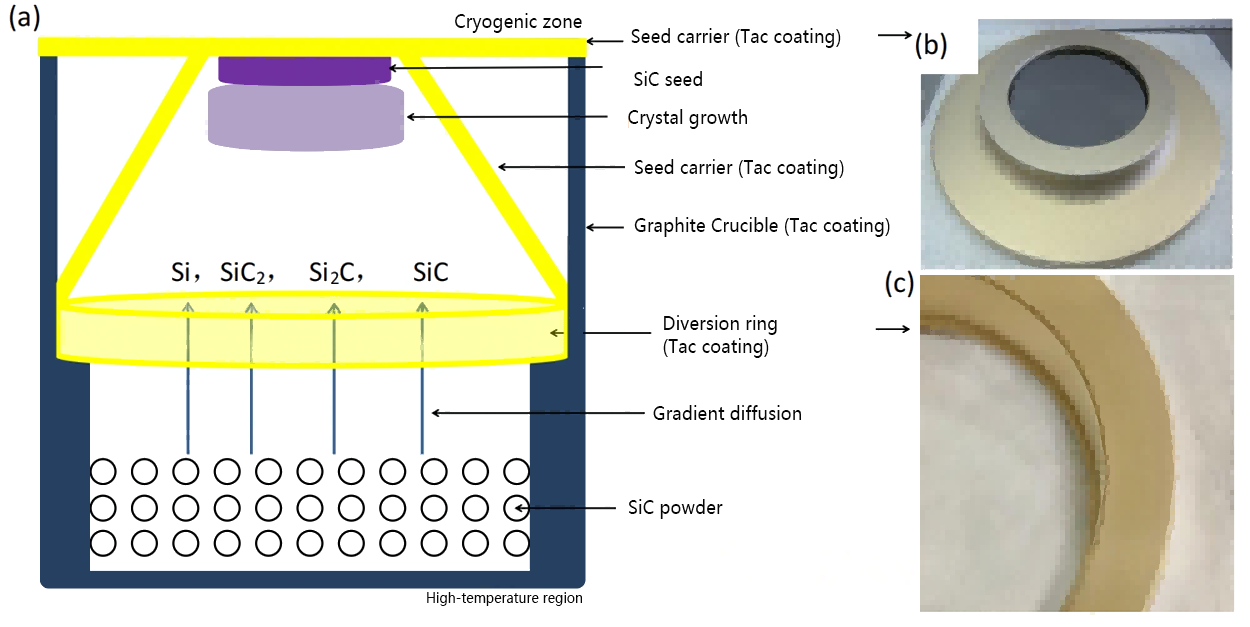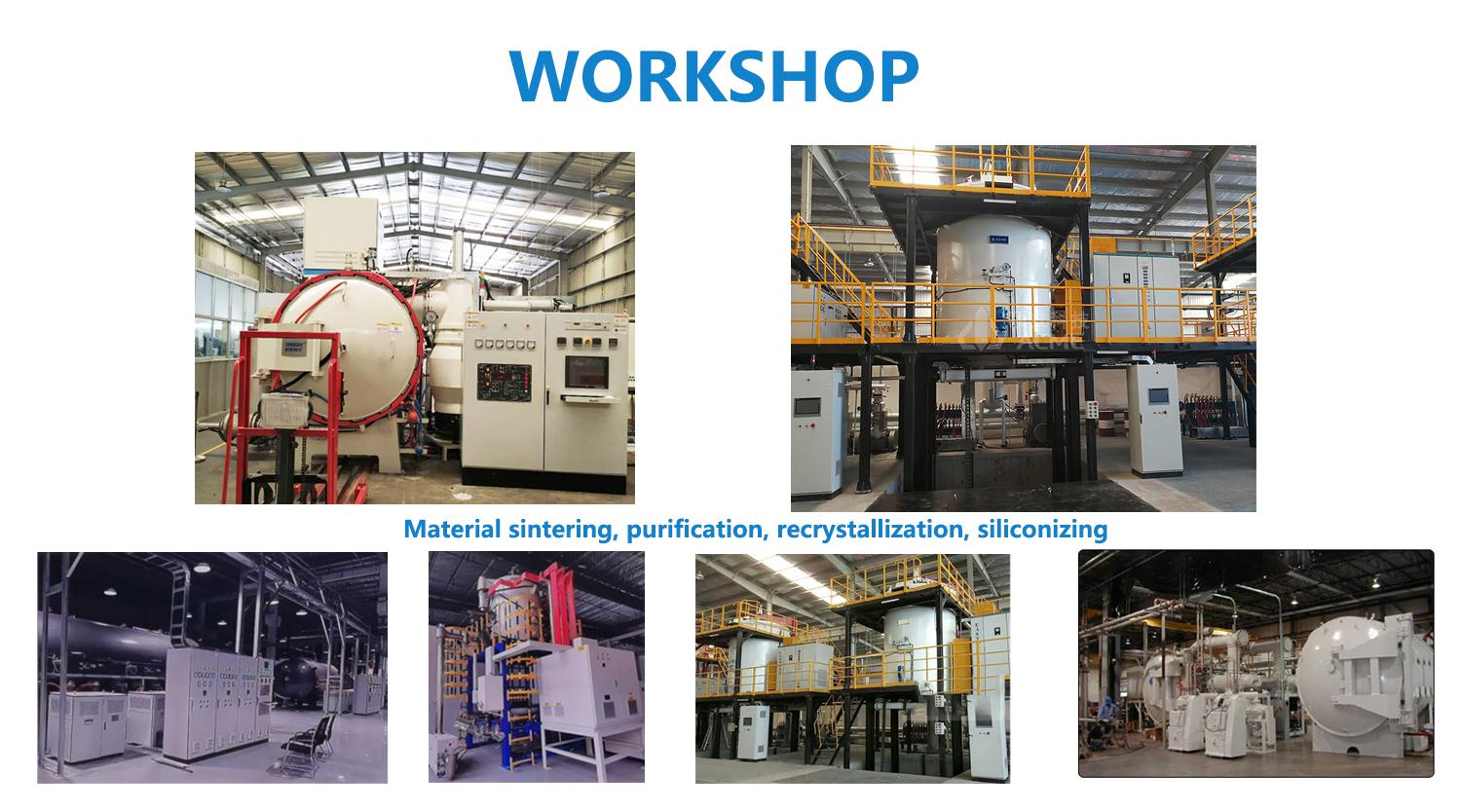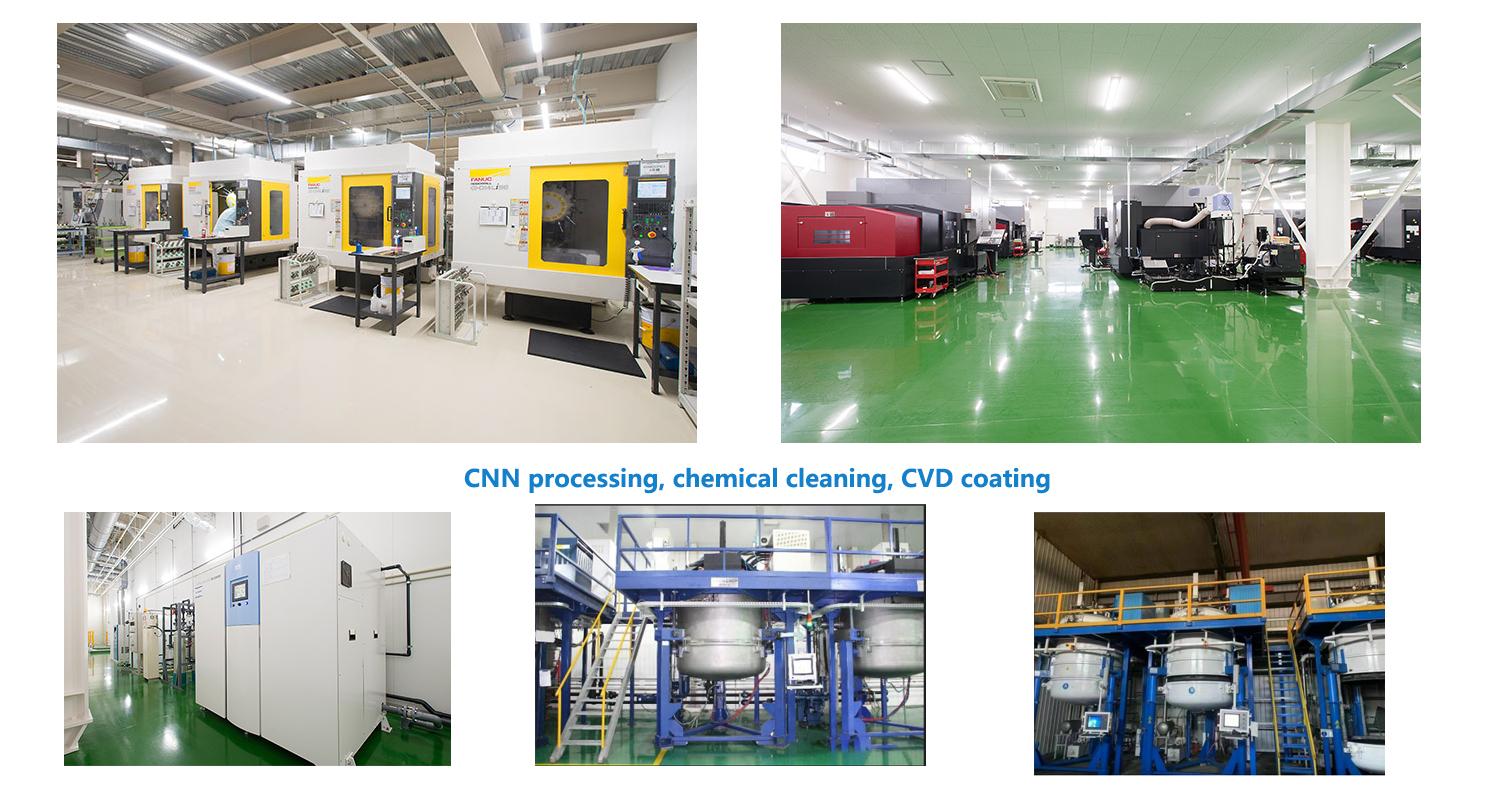
Tantal Carbide Beschichtung hat die Effizienz von Angreifern in Hochleistungsindustrien revolutioniert. Seine Fähigkeit, extremen Temperaturen standzuhalten, bis zu 2300 Grad Celsius, sorgt für gleichbleibende Leistung in der Halbleiterfertigung. Im Gegensatz zu herkömmlichen Materialien wie tac beschichtung graphit, TaC CVD Beschichtung bietet überlegene thermische Stabilität und chemische Beständigkeit. Diese Eigenschaften machen es unverzichtbar für Anwendungen, die Präzision und Haltbarkeit erfordern.
Semiceras Tantal Carbide TaC CVD Beschichtung Wafer Susceptor zeigt unübertroffene Hochtemperaturbeständigkeit und Reinheit. Es verbessert die Qualität von SiC-Wafern und erweitert die Lebensdauer von kritischen Komponenten. Stabilität der Beschichtung bei Temperaturen größer als 2000 °C ausformungen SiC-Beschichtungen, die bei 1200-1400 °C abbauen. Diese Innovation setzt einen neuen Standard für waferanfälligkeit zu erkunden in der modernen fertigung.
Vergleich:
| Feature | TaC CVD Beschichtung | Traditionelle Materialien |
|—————————–|———————–|——————————-|
| Maximale Temperatur | 2300 Grad Celsius sublimiert bei hohen Temperaturen |
| Service Leben | Länger | kürzer |
| Hohe Reinheit | Ja | Varianten |
| Chemische Toleranz | Hohe | Unter |
Semicera’s TaC beschichtete Graphitofenkomponenten beispiellose zuverlässigkeit gewährleisten, dass hersteller optimale ergebnisse in anspruchsvollen umgebungen erzielen.
Wichtigste Erkenntnisse
- TaC CVD Beschichtung sehr hohe Wärme bis 2300° C. Es funktioniert gut in harten Umgebungen.
- Die Beschichtung widersteht starken Chemikalien und schützt Anfälligkeiten vor Beschädigungen. Dadurch bleiben sie länger und senken die Reparaturkosten.
- Verwendung von TaC CVD Beschichtung hält die Halbleiterproduktion sauber. Dies hilft, bessere Produkte zu machen und die Erfolgsquoten zu erhöhen.
- TaC CVD Beschichtung macht Anfälligkeiten stärker und härter zu tragen. Dies hält sie gut und reduziert Verzögerungen.
- Branchen wie Luftfahrt und chemische Verarbeitung verwenden diese Beschichtung. Es hilft Teilen bleiben stark bei harten Bedingungen.
Was ist TaC CVD Coating?
Definition und Prozess
TaC CVD Beschichtung oder Tantal Carbide Chemical Vapor Deposition Beschichtung, ist ein leistungsfähiges Material angewendet, um die Effizienz und Haltbarkeit von Angreifern zu verbessern. Diese Beschichtung wird durch eine chemisches Reaktionssystem mit TaCl5, C3H6, H2 und Ar. Argon wirkt als Verdünnungs- und Traggas und gewährleistet eine gleichmäßige Abscheidung. Das Verfahren beinhaltet eine präzise Steuerung von Gasdurchsatz, Abscheidetemperatur und Druck. Diese Parameter beeinflussen die Oberflächenmorphologie der Beschichtung, die chemische Zusammensetzung und die innere Spannung, was zu einer robusten und zuverlässigen Schicht führt.
Schlüsseleigenschaften von TaC CVD Beschichtung
Tantalcarbid zeigt außergewöhnliche mechanische und thermische Eigenschaften, so dass es ideal für Hochtemperatur- und korrosive Umgebungen. Seine chemische Zusammensetzung und Struktur sind nachstehend zusammengefasst:
| Eigentum | Wert |
|---|---|
| Dichte | 14,3 (g/cm3) |
| Massenkonzentration | 8 x 10^15/cm |
| Spezifische Emissivität | 0.3 |
| Wärmeausdehnungskoeffizient | 6.3 x 10^-6/K |
| Härte (HK) | 2000 HK |
| Bulk Resistance | 4,5 ohm-cm |
| Widerstand | 1 x 10^-5 Ohm*cm |
| Thermische Stabilität | < 2500°C |
| Mobilität | 237 cm2/V |
| Beschichtung Dicke | typischer wert ≥20 |
Diese Beschichtung verfügt auch über einen Schmelzpunkt von 4273 °C und widersteht Hochgeschwindigkeitsluftstrom und Ablation. Seine Fähigkeit, korrosive Mittel wie H2, HCl und NH3 zu widerstehen, macht es in der Halbleiterherstellung unverzichtbar.
Warum TaC CVD Beschichtung ist ideal für Suszeptoren
TaC CVD Beschichtung verbessert suszeptor-Leistung durch die Bereitstellung unübertroffener thermischer Stabilität, chemischer Beständigkeit und Haltbarkeit. Es hält strukturelle Integrität bei Temperaturen über 2300 °C, übertrifft traditionelle Materialien wie Siliziumkarbid. Seine hohe Härte und Korrosionsbeständigkeit schützen Anfälligkeiten vor Verschleiß und chemischem Abbau, wodurch eine längere Lebensdauer gewährleistet wird. Darüber hinaus minimiert die Reinheit der Beschichtung die Verschmutzung, verbessert die Qualität von SiC-Wafern und Epitaxieschichten. Diese Attribute machen es zur bevorzugten Wahl für anspruchsvolle Anwendungen wie SiC Wafer Wachstum und GaN LED Produktion.
Wie TaC CVD Beschichtung verbessert Effizienz

Verbesserte thermische Stabilität
TaC CVD Beschichtung bietet außergewöhnliche thermische Stabilität, so dass es ideal für Hochtemperaturanwendungen. mit einem Schmelzpunkt von etwa 3880°C, tantalcarbid kann extremer hitze standhalten ohne Schmelzen oder Abbauen. Diese Eigenschaft ermöglicht es der Beschichtung, ihre strukturelle Integrität auch in Umgebungen von mehr als 2000° zu erhalten C. Im Vergleich zu herkömmlichen Siliziumcarbid (SiC)-Beschichtungen beginnen, sich bei viel niedrigeren Temperaturen zu zersetzen, typischerweise zwischen 1200-1400° C. Dieser signifikante Unterschied sorgt dafür, dass die TaC CVD Beschichtung das Graphitsubstrat vor thermischen Beschädigungen schützt und seine Leistung und Zuverlässigkeit bei anspruchsvollen Prozessen wie SiC-Waferwachstum verbessert.
Note: Die Fähigkeit von TaC CVD Coating, solche hohen Temperaturen zu ertragen, verbessert nicht nur die Effizienz von Suszeptoren, sondern reduziert auch das Risiko von Prozessunterbrechungen durch Materialausfall.
Verbesserte Chemikalienbeständigkeit
Die chemische Beständigkeit der TaC CVD Coating unterscheidet sie von anderen Materialien. Tantalcarbid zeigt eine ausgezeichnete Stabilität gegen die meisten Säuren und Laugen und schützt das Substrat effektiv vor korrosiven Umgebungen. Forschung hat gezeigt, dass eine auf Graphit abgeschiedene 150 μm dicke TaC-Beschichtung nach einer Temperaturbelastung von bis zu 2000° ihre Integrität aufrechterhalten hat. C. Diese Robustheit sorgt dafür, dass die Beschichtung auch unter harten Bedingungen mit reaktiven Gasen wie H2, HCl und NH3 intakt bleibt. Durch die Verhinderung des chemischen Abbaus erweitert die TaC CVD Coating die Lebensdauer von Suszeptoren und gewährleistet eine gleichbleibende Leistung bei der Halbleiterherstellung.
Erhöhte Haltbarkeit und Verschleißfestigkeit
Die Haltbarkeit von TaC CVD Coating verbessert die Verschleißfestigkeit von Angreifern und macht sie zuverlässiger über längere Zeiträume. Seine hohe Härte, gemessen bei 2000 HK, schützt vor mechanischen Verschleiß und Oberflächenschäden. Diese Eigenschaft ist besonders vorteilhaft bei Anwendungen, bei denen Anfälligkeiten abrasiven Bedingungen oder häufigen thermischen Radfahren ausgesetzt sind. Die Verträglichkeit der Beschichtung mit Graphit- und Kohlenstoff-Verbundwerkstoffen stärkt die Fähigkeit, mechanischer Beanspruchung standzuhalten. Durch die Reduzierung von Verschleiß minimiert die TaC CVD Coating Wartungsanforderungen und sorgt für einen unterbrechungsfreien Betrieb in kritischen Fertigungsprozessen.
Tipp: Hersteller mit TaC CVD Die Beschichtung profitiert von reduzierter Ausfallzeit und verbesserter betrieblicher Effizienz, so dass sie eine kostengünstige Lösung für leistungsstarke Branchen.
Schlüsselvorteile von TaC CVD Beschichtung
Erweiterte Lebensdauer von Anhängern
TaC CVD Beschichtung deutlich verlängert die Lebensdauer der Angreifer durch die Verbesserung ihrer Beständigkeit gegen extreme Temperaturen und korrosive Umgebungen. Seine hohe Härte und Haltbarkeit schützen Anfälligkeiten vor mechanischem Verschleiß und chemischem Abbau, wodurch eine langfristige Zuverlässigkeit gewährleistet ist. Die Fähigkeit der Beschichtung, strukturelle Integrität bei Temperaturen von mehr als 2000° zu erhalten C reduziert die Häufigkeit der Ersetzungen und senkt die Wartungskosten. Diese Haltbarkeit macht es zu einer idealen Wahl für Industrien, die eine gleichbleibende Leistung unter harten Bedingungen erfordern.
Verminderte Kontamination in Fertigungsprozessen
Die Verwendung von TaC CVD Coating minimiert Verunreinigungen in Halbleiterherstellungsprozessen. Seine außergewöhnliche chemische Beständigkeit verhindert die Freisetzung von Verunreinigungen und hält die strengen Reinheitsstandards, die in dieser Branche erforderlich sind. Der TaC Coated Ring verbessert die Leistung und Zuverlässigkeit von Halbleiter-Ausrüstungen durch Verschleiß und Verschmutzung. Diese Haltbarkeit sorgt nicht nur für sauberere Fertigungsumgebungen, sondern trägt auch zu höheren Ertragsraten und verbesserter Geräteleistung bei.
Verbesserte Prozesskonsistenz und Ertrag
TaC CVD Beschichtung spielt eine kritische rolle bei der Verbesserung der Prozesskonsistenz und -ausbeute bei der Halbleiterherstellung. Seine fortschrittlichen Materialien schützen lebenswichtige Komponenten, um ihre Langlebigkeit und Leistung in Hochtemperatur-Umgebungen zu gewährleisten. Durch die Reduzierung von Kontaminationsrisiken und die Sicherstellung eines einheitlichen Wärmemanagements verbessern die TaC-beschichteten Komponenten die Prozessstabilität. Diese Optimierung ist besonders vorteilhaft bei der Herstellung von GaN LEDs und SiC-Leistungsgeräten, bei denen Präzision und Qualität an erster Stelle stehen.
Tantalcarbidbeschichtungen sind im epitaktischen Prozess von GaN LEDs und SiC-Power-Geräten mit MOCVD unverzichtbar. Diese Beschichtungen schützen kritische Bauteile und gewährleisten ihre Haltbarkeit und Leistungsfähigkeit bei den anspruchsvollen Bedingungen der Halbleiterfertigung.
- Integration der TaC-Beschichtung auf Graphitreaktorkomponenten optimiert prozessausbeute und produktqualität.
- Besonders vorteilhaft ist es bei der Herstellung von GaN- und SiC-Geräten, die für LEDs und Leistungselektronik wesentlich sind.
- Durch die Verringerung der Kontaminationsrisiken sorgen TaC-beschichtete Bauteile für höhere Erträge und eine bessere Produktqualität.
Anwendungen von TaC CVD Beschichtungen in der Industrie

Halbleiterfertigung und SiC Wafer Wachstum
TaC CVD Die Beschichtung spielt eine zentrale Rolle bei der Halbleiterherstellung, insbesondere bei SiC-Waferwachstum. Sie hochfeste und korrosionsbeständige eigenschaften macht es unverzichtbar für Prozesse wie MOCVD, wo es Graphitsubstrate vor chemischem und thermischem Abbau schützt. Die Beschichtung gewährleistet eine gereinigte Wachstumsumgebung durch Widerstand von Säuren und Alkalien wie H2, HCl und NH3.
Zu den wichtigsten Vorteilen in SiC Wafer Wachstum gehören:
- TaC-beschichtete Graphittiegel reduzieren den Stickstoffeinbau in SiC-Kristalle, minimieren Defekte.
- Trägerkonzentration in SiC-Wafern, die mit TaC-beschichteten Tiegeln angebaut werden, ist deutlich niedriger, verbesserung der kristallqualität.
- Die Beschichtung verlängert die Lebensdauer von Graphittiegeln, reduziert Wartungskosten und Ausfallzeiten.
Durch die Aufrechterhaltung der strukturellen Integrität bei hohen Temperaturen und thermischen Zyklen, TaC CVD Beschichtung verbessert die leistung und zuverlässigkeit von Halbleiteranlagen. Sie trägt auch zu höheren Ertragsraten bei, indem sie Verunreinigungen minimiert und einheitliche Fertigungsverfahren gewährleistet.
Luft- und Hochtemperaturanwendungen
In Luft- und Raumfahrt, TaC CVD Die Beschichtung ist wesentlich für Bauteile, die extremen Temperaturen und Drücken ausgesetzt sind. Es bekleidet Turbinenschaufeln, Raketendüsen und thermische Schilde, die ihre Beständigkeit gegen Erosion und Oxidation verbessern. Diese Haltbarkeit reduziert den Bedarf an häufigen Austauschen und verbessert die Betriebseffizienz.
Die Beschichtung stärkt auch Graphitteile und eignet sich für hochbelastende Anwendungen. So halten z.B. TaC-beschichtete Turbinenschaufeln und Motorgehäuse harten Bedingungen stand und reduzieren das Gewicht im Vergleich zu Metallbauteilen. Diese Gewichtsreduktion verbessert die Kraftstoffeffizienz, ein kritischer Faktor in der Luft- und Raumfahrttechnik.
Chemische Verarbeitung und korrosive Umwelt
TaC CVD Die Beschichtung zeichnet sich durch außergewöhnliche Korrosionsbeständigkeit und chemische Stabilität in chemischen Verarbeitungsumgebungen aus. Es schützt Geräte wie Reaktoren, Wärmetauscher und Rohrleitungssysteme vor aggressiven Stoffen und sorgt für langfristige Zuverlässigkeit.
Die Säure- und Alkalibeständigkeit der Beschichtung, insbesondere gegen H2, HCl und NH3, schützt Graphitsubstrate vor Beschädigungen. Forschung zeigt, dass TaC-Beschichtungen auch bei 2000° stabil bleiben C, so dass sie ideal für Hochtemperatur-chemische Prozesse. Durch die Verlängerung der Lebensdauer kritischer Komponenten verbessert die TaC CVD Coating die Effizienz und Sicherheit chemischer Verarbeitungssysteme.
TaC CVD Beschichtung, exemplified by Semiceras Tantal Carbide TaC CVD Coating Wafer Susceptor, revolutioniert Susceptor Effizienz. Seine außergewöhnliche thermische Stabilität, chemische Beständigkeit und mechanische Haltbarkeit verlängern die Lebensdauer der Suszeptoren und minimieren die Verschmutzung. Diese Eigenschaften gewährleisten eine gleichbleibende Leistung in anspruchsvollen Umgebungen wie der Halbleiterfertigung.
Schlüsselleistungen:
- Längere Lebensdauer aufgrund starke haftung und thermische stoßfestigkeit.
- Verminderte Verunreinigung durch ultrahohe Reinheit und chemische Stabilität.
- Verbesserte Prozesssicherheit, verbesserte Ertragsraten und betriebliche Effizienz.
Durch die Übernahme von TaC CVD Coating erreichen Branchen überlegene Qualität, Zuverlässigkeit und Produktivität und setzen neue Maßstäbe in der Fertigungsqualität.
FAQ
Was macht TaC CVD Überlegen von traditionellen Materialien?
TaC CVD Beschichtung bietet unübertroffene thermische Stabilität, chemische Beständigkeit und Haltbarkeit. Es hält Temperaturen bis 2300°C stand, weit über die Grenzen traditionelle materialien wie siliziumkarbid. Seine hohe Reinheit minimiert Verschmutzungen, sorgt für gleichbleibende Leistung und längere Lebensdauer in anspruchsvollen Anwendungen wie der Halbleiterbau.
Wie funktioniert TaC CVD Beschichtung verbessert die Produktionsausbeute?
TaC CVD Die Beschichtung verbessert die Prozesskonsistenz durch die Verringerung der Verunreinigung und die Erhaltung der strukturellen Integrität unter extremen Bedingungen. Diese Stabilität gewährleistet ein gleichmäßiges thermisches Management und minimiert Fehler in SiC-Wafern und GaN-LEDs. Die Hersteller profitieren von höheren Ertragsraten und verbesserter Produktqualität, was sie zu einer kostengünstigen Lösung macht.
Can TaC Lebenslauf Beschichtung widersteht korrosiven Umgebungen?
Ja, TaC CVD Die Beschichtung zeigt eine außergewöhnliche Beständigkeit gegenüber Säuren, Alkalien und reaktiven Gasen wie H2, HCl und NH3. Diese chemische Stabilität schützt Suszeptoren und andere Komponenten vor Degradation und gewährleistet eine zuverlässige Leistung in rauen Umgebungen wie Halbleiterreaktoren und chemischen Prozesssystemen.
Welche Branchen profitieren am meisten von TaC CVD Coating?
Branchen wie Halbleiterherstellung, Luft- und Raumfahrt und chemische Verarbeitung gewinnen signifikante Vorteile von TaC CVD Coating. Seine Hochtemperaturbeständigkeit, Haltbarkeit und chemische Stabilität machen es für Anwendungen unerlässlich, die Präzision, Zuverlässigkeit und langfristige Leistung unter extremen Bedingungen erfordern.
Wie funktioniert TaC CVD Beschichtung verlängern die Lebensdauer von Angreifern?
TaC CVD Beschichtung schützt Anfälligkeiten vor thermischen Schäden, chemischer Korrosion und mechanischem Verschleiß. Seine hohe Härte und Stabilität bei Temperaturen über 2000° C reduzieren den Bedarf an häufigen Ersetzungen. Diese Haltbarkeit senkt die Wartungskosten und sorgt für einen unterbrechungsfreien Betrieb in kritischen Fertigungsprozessen.